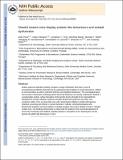Shank3 mutant mice display autistic-like behaviours and striatal dysfunction
Author(s)
Peca, Joao; Feliciano, Catia; Ting, Jonathan T.; Wang, Wenting; Wells, Michael F.; Venkatraman, Talaignair N.; Lascola, Christopher D.; Fu, Zhanyan; Feng, Guoping; ... Show more Show less
DownloadFeng_Shank3 mutant.pdf (2.171Mb)
OPEN_ACCESS_POLICY
Open Access Policy
Creative Commons Attribution-Noncommercial-Share Alike
Terms of use
Metadata
Show full item recordAbstract
Autism spectrum disorders (ASDs) comprise a range of disorders that share a core of neurobehavioural deficits characterized by widespread abnormalities in social interactions, deficits in communication as well as restricted interests and repetitive behaviours. The neurological basis and circuitry mechanisms underlying these abnormal behaviours are poorly understood. SHANK3 is a postsynaptic protein, whose disruption at the genetic level is thought to be responsible for the development of 22q13 deletion syndrome (Phelan–McDermid syndrome) and other non-syndromic ASDs. Here we show that mice with Shank3 gene deletions exhibit self-injurious repetitive grooming and deficits in social interaction. Cellular, electrophysiological and biochemical analyses uncovered defects at striatal synapses and cortico-striatal circuits in Shank3 mutant mice. Our findings demonstrate a critical role for SHANK3 in the normal development of neuronal connectivity and establish causality between a disruption in the Shank3 gene and the genesis of autistic-like behaviours in mice.
Date issued
2011-03Department
Massachusetts Institute of Technology. Department of Brain and Cognitive Sciences; McGovern Institute for Brain Research at MITJournal
Nature
Publisher
Nature Publishing Group
Citation
Peça, João, Cátia Feliciano, Jonathan T. Ting, Wenting Wang, Michael F. Wells, Talaignair N. Venkatraman, Christopher D. Lascola, Zhanyan Fu, and Guoping Feng. “Shank3 Mutant Mice Display Autistic-Like Behaviours and Striatal Dysfunction.” Nature 472, no. 7344 (April 28, 2011): 437–442.
Version: Author's final manuscript
ISSN
0028-0836
1476-4687